
Return to Aviation Answer-Man Gateway

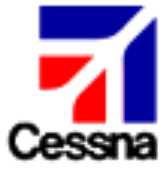 Return to Cessna History Timeline
Return to Cessna History Timeline
. . .
The history of
Copyright 2002 by Richard Harris
AUTHOR'S NOTE: This section repeats the story of the 310, but also includes the story of Cessna's other low-wing, prop-driven twins: 320, 335, 340, 401, 402, 404, 414, 421, 425, and 441, as well as the T303 Crusader.
Following on the lessons learned with the 310, Cessna (over the next 25 years) created a whole vast array of twin-engine designs -- largely copying much of the 310 (particularly the wings, tails and engines). By the late 1960's, the 310 had been stretched to include 6 people.
The Model 320 Skyknight (1962) is a 5/6-seat "stretched" Model 310, with slightly larger engines. Cruising at 260mph at high altitude, through the low drag of thin air, the Skyknight offered superb speed on modest horsepower -- for those willing to breathe oxygen from a bottle.
The Model 414 / Chancellor (1969) is intended as an "affordable" step-up to pressurization for owners of unpressurized, cabin-class airplanes. Essentially a Model 421 cabin (pressurized), fitted with a 401's wing and engines. Without the 421's troublesome geared engines, the superior reliability of the 414 -- and performance nearly comparable to the 421 -- soon made it the almost as popular as the top-of-the line Cessna propellor plane. By the end of production, in 1986, just over 1,000 of them had been built and sold.
Today, the Cessna twin-prop production lines are just a memory. Cessna is now split between building single-prop planes and building business jets. But many Cessna twins still soldier on -- particularly economical twins (the 310 and 340) and commercial/utility twins like the 402 and 404. Modern turboprops have made the Cessna piston-engined cabin-class line rather obsolete, and even Cessna's own economical 500-series Citation bizjets have eaten into the market for the 400-series. Still, for those who crave luxury and piston operating costs, the smaller 400-series remain popular. And the economical 441 Conquest II turboprop -- once the flagship of Cessna's propellor fleet, remains one of the most sought-after twins on the used market today. ~RH
Return to Aviation Answer-Man Gateway
low-wing
twin-engined Cessna
executive & commercial airplanes

All Rights Reserved
Not for public consumption.
Although this narrative is written in the present tense, to give a sense of actually traveling through time with Cessna Aircraft, these aircraft have all been discontinued by Cessna. During the Great Recession of 1981-1992, Cessna ended its entire production of propellor-driven aircraft. (Comments on this appear at the end of this article).
1954:
Cessna produces its first twin-engine civilian airplane, the efficient, speedy, 4-seat Model 310. With jet-fighter looks (helped by wingtip tanks) and 230mph speed, on a pair of 240-horsepower engines (enclosed in thin, streamlined nacelles), the 310 is a model of speed and efficiency for light twins of its time (of which there were few).
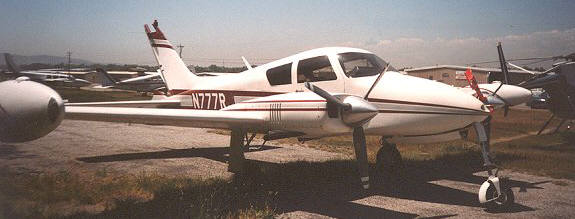 Capable of well over 200mph, the 310 draws the attention of serious business flyers, who are excited by its ability to fly faster than many of the airliners of the day. While 300mph turboprops are widely used between major airports (and jetliners are coming soon), smaller cities are still mostly linked by slower, pre-War-era airliners (DC-3's and such) which rarely travel faster than the 310's top speed). Able to land in shorter runways than the airliners typically use, the 310 opens more airports to the business flyer as well. The 310 becomes a hot, new asset to the business world.
Capable of well over 200mph, the 310 draws the attention of serious business flyers, who are excited by its ability to fly faster than many of the airliners of the day. While 300mph turboprops are widely used between major airports (and jetliners are coming soon), smaller cities are still mostly linked by slower, pre-War-era airliners (DC-3's and such) which rarely travel faster than the 310's top speed). Able to land in shorter runways than the airliners typically use, the 310 opens more airports to the business flyer as well. The 310 becomes a hot, new asset to the business world.
The hot 310 manages to become a Hollywood star, too, by becoming the plane flown by fictional TV hero "Sky King" -- replacing the character's war-surplus Cessna T-50 Bobcat. The publicity -- on a popular weekly television show -- can't help but feed sales.
 The U.S. Air Force, too, takes note of the speedy, efficient little twins, and decides to order dozens of them to expedite vital supplies, and to accommodate the travel needs of generals and other key personnel. By 1956, the Air Force orders 80 of them, under the military designation L-27A (later U-3B). (The L-27's Air Force paint scheme, however, soon earns it the unofficial nickname "Blue Canoe.")
The U.S. Air Force, too, takes note of the speedy, efficient little twins, and decides to order dozens of them to expedite vital supplies, and to accommodate the travel needs of generals and other key personnel. By 1956, the Air Force orders 80 of them, under the military designation L-27A (later U-3B). (The L-27's Air Force paint scheme, however, soon earns it the unofficial nickname "Blue Canoe.")
The Blue Canoe program is the first time that the Air Force contracts with a manufacturer to provide a plane's overhauls and major maintenance -- a major new concept in efficiency for Air Force procurement, which will be used increasingly in years to come.
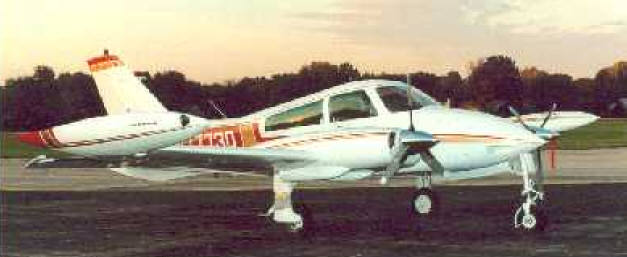 The 310 remains in continuous production until 1981, by which time over 5,000 would be built and sold. Despite its well-deserved reputation as a "hot" plane that is tricky to land, the Model 310 remains a popular hallmark of speed, efficiency, and sex-appeal in light twins.
The 310 remains in continuous production until 1981, by which time over 5,000 would be built and sold. Despite its well-deserved reputation as a "hot" plane that is tricky to land, the Model 310 remains a popular hallmark of speed, efficiency, and sex-appeal in light twins.
The 310, though, is more important to Cessna Aircraft for its transforming role for the company. In 1954, this plane lifts Cessna from the ranks of "puddle-jumper" plane builders, to resume its pre-war place in the ranks of "speed machines" and "executive aircraft."
Over the next quarter-century, other modifications and evolutions of the 310 included the following planes (listed in approximately the order they were introduced):
 The Model 411 (1965) is luxury twin, with powerful (but thristy, finicky) geared engines, on a modified 310/320 wing, with a roomy cabin big enough for passengers to almost stand upright in. As with airliners, the cockpit is separated from the passenger compartment with a partition, allowing privacy for business excutives, and blocking out distracting noises and voices from the cockpit, and the plane even has a toilet compartment, of sorts. The 411 seats 6-8, cruises at 245mph (top speed 268mph) and ranges up to 1,500 miles. This "cabin-class" twin, with an aisle between the seats, like a mini-airliner, makes long flights practical for business executives and their guests.
The Model 411 (1965) is luxury twin, with powerful (but thristy, finicky) geared engines, on a modified 310/320 wing, with a roomy cabin big enough for passengers to almost stand upright in. As with airliners, the cockpit is separated from the passenger compartment with a partition, allowing privacy for business excutives, and blocking out distracting noises and voices from the cockpit, and the plane even has a toilet compartment, of sorts. The 411 seats 6-8, cruises at 245mph (top speed 268mph) and ranges up to 1,500 miles. This "cabin-class" twin, with an aisle between the seats, like a mini-airliner, makes long flights practical for business executives and their guests.
This makes Cessna business planes much more competitive with the airlines (who had increased the competition for the business flyer with the introduction of fast, high-flying turboprop airliners on smaller routes, and even faster, higher-flying jets between major cities). More importantly, with the 411, Cessna effectively plays "catch-up" with Beech Aircraft, whose elegant cabin-class Queen Air had become the defining standard in piston-engined executive aircraft. While never as popular as the Queen Air, the 411, built until 1967, would become the defining plane for the Cessna "400-series" big twins, which would soon become popular.
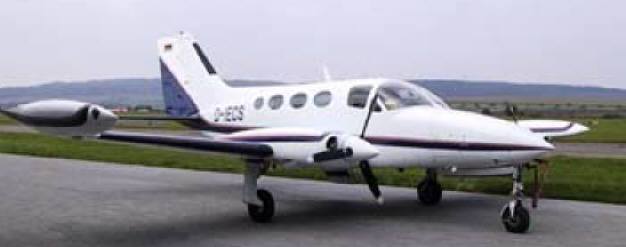 The Model 401 (1966) is an economy model of the cabin-class Model 411 -- replacing the 411's 340-horsepower geared engines with simpler, cheaper, 300-horsepower, non-geared engines. It was marketed as a medium-range, executive plane, with "elbow room" -- particularly practical for companies flying key personnel short distances between low-altitude cities, particularly along the crowded U.S. coasts and throughout most of Europe. Seats 6-8, cruises at 240mph (top speed 261mph) up to 800 miles. The lack of pressurization, however, made it ill-suited to long flights over high mountains or severe weather. It would only take Cessn another year to solve that problem
The Model 401 (1966) is an economy model of the cabin-class Model 411 -- replacing the 411's 340-horsepower geared engines with simpler, cheaper, 300-horsepower, non-geared engines. It was marketed as a medium-range, executive plane, with "elbow room" -- particularly practical for companies flying key personnel short distances between low-altitude cities, particularly along the crowded U.S. coasts and throughout most of Europe. Seats 6-8, cruises at 240mph (top speed 261mph) up to 800 miles. The lack of pressurization, however, made it ill-suited to long flights over high mountains or severe weather. It would only take Cessn another year to solve that problem
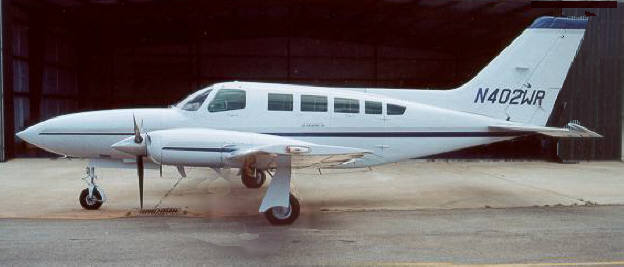 The Model 402 Businessliner/UtiliLiner (1966) was a Model 401 with an enlarged nose, baggage compartment and doors, and high-density seating (packing up to 10 people into the plane) so that the plane could be efficiently used as a commuter airliner. The seats removed quickly so the plane could be converted to heavy cargo hauling. The plane is an instant hit with many tiny commuter airlines, air charter, and air cargo services. Cruise speed 210mph (top speed 260mph) in later verions, with ranges up to 450 miles, depending upon the load. Efficient, affordable, and capable, the 402 quickly becomes the airliner of choice for many smaller, poorer countries. In the U.S. and Europe it becomes a major force in the development of commuter airlines, charter services, and air-cargo companies. By the end of its production run, in 1986, over 1,500 had been sold around the world.
The Model 402 Businessliner/UtiliLiner (1966) was a Model 401 with an enlarged nose, baggage compartment and doors, and high-density seating (packing up to 10 people into the plane) so that the plane could be efficiently used as a commuter airliner. The seats removed quickly so the plane could be converted to heavy cargo hauling. The plane is an instant hit with many tiny commuter airlines, air charter, and air cargo services. Cruise speed 210mph (top speed 260mph) in later verions, with ranges up to 450 miles, depending upon the load. Efficient, affordable, and capable, the 402 quickly becomes the airliner of choice for many smaller, poorer countries. In the U.S. and Europe it becomes a major force in the development of commuter airlines, charter services, and air-cargo companies. By the end of its production run, in 1986, over 1,500 had been sold around the world.
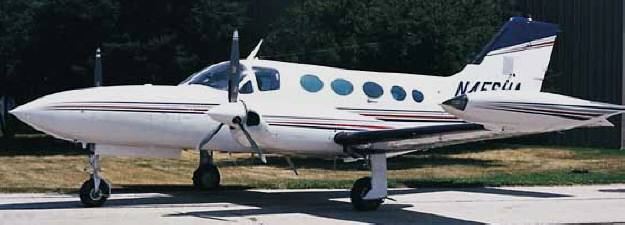 The Model 421 (1967) is a beefed-up Model 411, with a pressurized cabin. Pressurizing the cabin makes it possible for the passengers to suffer fewer discomforting effects (particularly "ear-popping") associated with altitude changes, while permitting sufficient breathing air for flight in the thin air at high altitudes, to overfly bad weather and high mountains (up to 30,000 feet for the 421). Commonly outfitted with weather radar and deicing boots, this smooth-riding, heavy plane puts Cessna in "the big leagues," with an "all-weather" airplane that can clear most of the bad weather, and all the mountains, that airliners routinely hurdle.
The Model 421 (1967) is a beefed-up Model 411, with a pressurized cabin. Pressurizing the cabin makes it possible for the passengers to suffer fewer discomforting effects (particularly "ear-popping") associated with altitude changes, while permitting sufficient breathing air for flight in the thin air at high altitudes, to overfly bad weather and high mountains (up to 30,000 feet for the 421). Commonly outfitted with weather radar and deicing boots, this smooth-riding, heavy plane puts Cessna in "the big leagues," with an "all-weather" airplane that can clear most of the bad weather, and all the mountains, that airliners routinely hurdle.
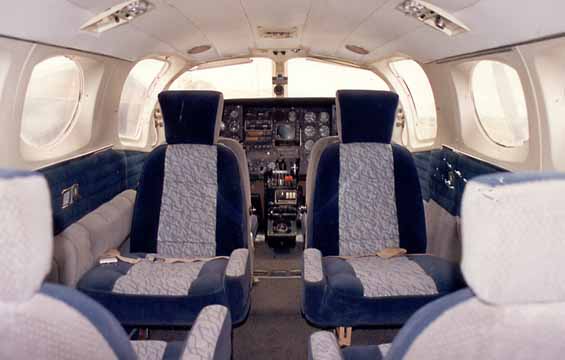 Seating 8-10, at speeds up to 290mph (typically cruising at 240mph at 20,000 feet), the 421 (later surnamed "Golden Eagle") would become the flagship of the Cessna fleet for nearly a decade -- through the 1960's, and into the 1970's. It would help Cessna stand up to its cross-town rival, Beech Aircraft, who had gained the upper hand in executive aircraft in the 1960's with its turboprop, cabin-class King Air. While the Beech King Air could soar higher and faster, the turbo-charged, piston-engined Cessna 421 is not far behind, with considerably less purchase cost and fuel consumption (though the troublesome geared engines added to the 421's operating costs). Production ended in 1985, with over 1,900 sold worldwide.
Seating 8-10, at speeds up to 290mph (typically cruising at 240mph at 20,000 feet), the 421 (later surnamed "Golden Eagle") would become the flagship of the Cessna fleet for nearly a decade -- through the 1960's, and into the 1970's. It would help Cessna stand up to its cross-town rival, Beech Aircraft, who had gained the upper hand in executive aircraft in the 1960's with its turboprop, cabin-class King Air. While the Beech King Air could soar higher and faster, the turbo-charged, piston-engined Cessna 421 is not far behind, with considerably less purchase cost and fuel consumption (though the troublesome geared engines added to the 421's operating costs). Production ended in 1985, with over 1,900 sold worldwide.
 The Model 340 (1972) takes the wings, engine and tail of the 6-seat turbo-charged 1972 model of the Model 310, and mates it with a 6-seat pressurized cabin-class fuselage, like a miniature model 421 or 414. Cruising at 241mph at 24,000 feet, the 340 can clear most weather and most mountains with ease. The Model 340 -- with a price comparable to a light twin -- was commonly marketed to the well-heeled owner/pilot, rather than to the aviation departments of large corporations. This began Cessna's move to add pressurization to smaller and smaller aircraft, bringing the comfort of pressurization, and the efficiency and safety of high-altitude flight (above bad weather) to more and more general aviation flyers.
The Model 340 (1972) takes the wings, engine and tail of the 6-seat turbo-charged 1972 model of the Model 310, and mates it with a 6-seat pressurized cabin-class fuselage, like a miniature model 421 or 414. Cruising at 241mph at 24,000 feet, the 340 can clear most weather and most mountains with ease. The Model 340 -- with a price comparable to a light twin -- was commonly marketed to the well-heeled owner/pilot, rather than to the aviation departments of large corporations. This began Cessna's move to add pressurization to smaller and smaller aircraft, bringing the comfort of pressurization, and the efficiency and safety of high-altitude flight (above bad weather) to more and more general aviation flyers.
The Model 335 is a Model 340, with the big cabin, but without pressurization -- for buyers who like the spacious cabin, and didn't need the hassles and expense of pressurization (particularly those flying short hops between low-lying cities along coastal areas). Relieved of the extra weight and engine-load of pressurization, the 335 has about the same performance as 340, using slightly-less-powerful engines, and carrying a few more pounds of people and baggage.
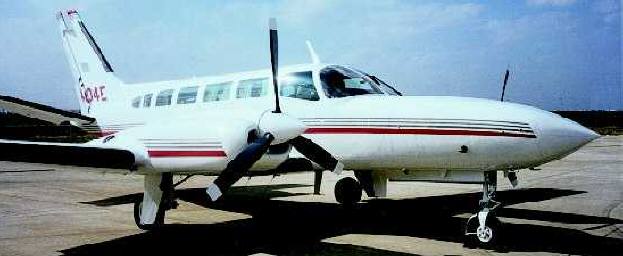 The Model 404 Titan (1977) is a slightly stretched Model 402 commuter/cargo plane, with bigger engines (375hp each, vs. the 402's 325hp each). Again, like the 402 before it, the plane is an instant hit with many small commuter airlines -- as well as some charter and cargo services. Seating up to 10, the 404 cruises at 210mph (top speed 250mph), up to 1,600 miles (though few passengers would welcome the 7-and-a-half hours for such a long flight).
The Model 404 Titan (1977) is a slightly stretched Model 402 commuter/cargo plane, with bigger engines (375hp each, vs. the 402's 325hp each). Again, like the 402 before it, the plane is an instant hit with many small commuter airlines -- as well as some charter and cargo services. Seating up to 10, the 404 cruises at 210mph (top speed 250mph), up to 1,600 miles (though few passengers would welcome the 7-and-a-half hours for such a long flight).
 The Titan will be offered in three versions: the Ambassador, for executive seating (typically 6-8 seats), the Freighter (for pure cargo hauling), and the Courier (left) -- a commuter plane designed for quick removal of the seats, to accommodate changes between passenger and cargo service. Efficient, affordable (compared to other planes with its capabilites), and capable, the unpressurized, 404 quickly becomes popular with small countries, especially low-altitude. By the time it was discontinued in the recession of 1982, 378 had been sold around the world.
The Titan will be offered in three versions: the Ambassador, for executive seating (typically 6-8 seats), the Freighter (for pure cargo hauling), and the Courier (left) -- a commuter plane designed for quick removal of the seats, to accommodate changes between passenger and cargo service. Efficient, affordable (compared to other planes with its capabilites), and capable, the unpressurized, 404 quickly becomes popular with small countries, especially low-altitude. By the time it was discontinued in the recession of 1982, 378 had been sold around the world.
 The Model 441 Conquest / Conquest II (1977) would be a basically new design -- Cessna's first turboprop twin -- drawing somewhat on the 421's basic design, but mostly a new plane. With the powerful Garrett AirResearch TPE-331 turboprop engines (635hp ea.), capable of lifting the plane to 35,000 (with an optional high-altitude modification kit) and blasting the plane along at 350mph, with up to 9 passengers, for up to 1,700 miles. It was the pinnacle of Cessna's propellor-engined line.
The Model 441 Conquest / Conquest II (1977) would be a basically new design -- Cessna's first turboprop twin -- drawing somewhat on the 421's basic design, but mostly a new plane. With the powerful Garrett AirResearch TPE-331 turboprop engines (635hp ea.), capable of lifting the plane to 35,000 (with an optional high-altitude modification kit) and blasting the plane along at 350mph, with up to 9 passengers, for up to 1,700 miles. It was the pinnacle of Cessna's propellor-engined line.
However, the Conquest would undergo a disastrous start, as apparently defective tails came off in flight, causing crashes. But with a factory recall of all planes to fix the problem, the production resumes (under the name Conquest II), and the 441 sales picked up. Commericial operators soon lusted after Conquest II's -- which could carry more stuff (or people) faster, father and cheaper than anything comparably priced.
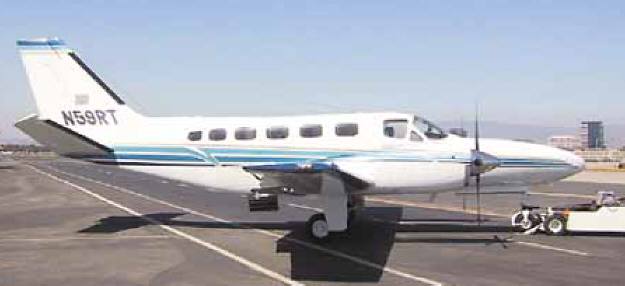 But the 441 is in released into a market already saturated with turboprops, particularly the various versions of the King Air from cross-town rival, Beech Aircraft. Other turboprops from Piper (Cheyenne I, II, IIXL, III, IV), Aero Commander (690, 690B, 695, 840, 900, 980, 1000 ), Mitsubishi, and others had filled most of the demand. The false start caused by the faulty tail had hurt sales badly, and by the time that the problem was solved, and customers were ready to buy, the long, bitter recession of the 1980's was just beginning. Only 353 were sold during their 9-year production run, discontinued in 1986. However, owing to their superb mix of performance and efficiency, for the price, over a decade and a half later they become highly sought after in the used market.
But the 441 is in released into a market already saturated with turboprops, particularly the various versions of the King Air from cross-town rival, Beech Aircraft. Other turboprops from Piper (Cheyenne I, II, IIXL, III, IV), Aero Commander (690, 690B, 695, 840, 900, 980, 1000 ), Mitsubishi, and others had filled most of the demand. The false start caused by the faulty tail had hurt sales badly, and by the time that the problem was solved, and customers were ready to buy, the long, bitter recession of the 1980's was just beginning. Only 353 were sold during their 9-year production run, discontinued in 1986. However, owing to their superb mix of performance and efficiency, for the price, over a decade and a half later they become highly sought after in the used market.
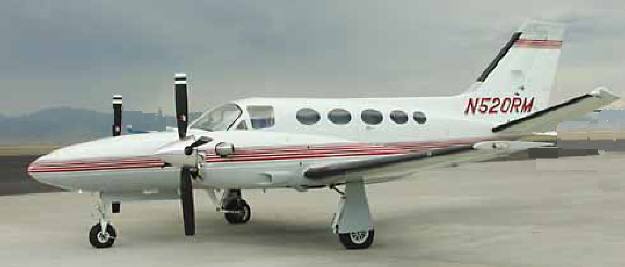 The Model 425 Corsair / Conquest I (1980) was a Model 421 (also pressurized) but with the 421's troublesome geared engines replaced by the dependable, powerful turboprop engines (Pratt & Whitney PT-6A, 450hp ea.). Cruising at 280mph (top speed 305mph), while seating 6-8, the Corsair was not particularly striking, compared with the established competition from the Beech King Air 90 and the various models of the Piper Cheyenne and Aero Commander. Several other turboprops were also established in the market by the time the Corsair showed up. The criticism of the plane sometimes boiled down to "too little, too late." Compared with other Cessna twins, the Corsair was not a blazing success. By the end of production in 1985, only 226 had been shipped.
The Model 425 Corsair / Conquest I (1980) was a Model 421 (also pressurized) but with the 421's troublesome geared engines replaced by the dependable, powerful turboprop engines (Pratt & Whitney PT-6A, 450hp ea.). Cruising at 280mph (top speed 305mph), while seating 6-8, the Corsair was not particularly striking, compared with the established competition from the Beech King Air 90 and the various models of the Piper Cheyenne and Aero Commander. Several other turboprops were also established in the market by the time the Corsair showed up. The criticism of the plane sometimes boiled down to "too little, too late." Compared with other Cessna twins, the Corsair was not a blazing success. By the end of production in 1985, only 226 had been shipped.
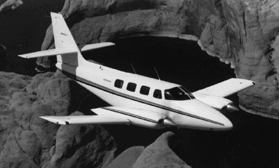 The T303 Crusader (1981) is one of Cessna's rare forays into the unknown. It is one of Cessna's revolutionary designs (revolutionary for Cessna that is), and like some of Cessna's other "revolutionary" departures, it crashes. It really doesn't belong in this section (the other planes, above, are related to each other, and have some commonality in design). But the T303 -- which sells in small numbers -- is not important enough to have its own chapter, nor to be a special topic in the main history of Cessna, so it belongs here, at the end of the Cessna low-wing twins -- about where it appeared in the chronological order of things. And it is an intriguing plane.
The T303 Crusader (1981) is one of Cessna's rare forays into the unknown. It is one of Cessna's revolutionary designs (revolutionary for Cessna that is), and like some of Cessna's other "revolutionary" departures, it crashes. It really doesn't belong in this section (the other planes, above, are related to each other, and have some commonality in design). But the T303 -- which sells in small numbers -- is not important enough to have its own chapter, nor to be a special topic in the main history of Cessna, so it belongs here, at the end of the Cessna low-wing twins -- about where it appeared in the chronological order of things. And it is an intriguing plane.
Powered by a pair of 250-horsepower turbocharged Continentals, the Crusader cruised at 225mph (top speed 248mph), at 20,000 (where the crew and passengers would have to wear oxygen masks.) The plane had seating for six, in a rather sparse interior. The T303 introduced counter-rotating engines (a safety advance pioneered by Piper Aircraft a decade earlier, which eliminates dangerous adverse turning forces from the right engine during an engine failure.) The name "Crusader" may have been inspired, in part, by the "cruciform" (cross-shaped) tail.
I must confess inadquate knowledge of the motivation to build this contraption. At first glance, it seems to have been a feeble attempt to slap together a cheap, cheap, "cabin-class" unpressurized twin. Perhaps intended to offer a bit extra headroom for tall people (which business executives often are). My personal suspicion is that it was a starting point for building a newer sytle of pressurized cabin-class twin, more cheaply than the fairly complex metalwork of the 400-series. Then, again, it may have just been an attempt at turning out some cheapo short-haul, mini-airliners for third-world operators.
 However, some analysts have indicated that it was an attempt to come up with a low-end twin to compete with the two very-cost-effective, very-light twins that Piper and Beech had recently developed from their light-single-engine lines. Piper had developed the Seminole (left) from its Cherokee line, and Beech developed the nearly-identical Duchess (below right) from its Model 23 Musketeer line. These inexpensive, efficient light twins had grabbed a big share of the twin-engine market away from Cessna, and would likely develop brand loyalty in customers who had a high likelihood of moving up to larger twins someday. That made these designs a threat to the entire Cessna twin line.
However, some analysts have indicated that it was an attempt to come up with a low-end twin to compete with the two very-cost-effective, very-light twins that Piper and Beech had recently developed from their light-single-engine lines. Piper had developed the Seminole (left) from its Cherokee line, and Beech developed the nearly-identical Duchess (below right) from its Model 23 Musketeer line. These inexpensive, efficient light twins had grabbed a big share of the twin-engine market away from Cessna, and would likely develop brand loyalty in customers who had a high likelihood of moving up to larger twins someday. That made these designs a threat to the entire Cessna twin line.
 Cessna's only alternatives to the Piper & Beech "T-Twins" were the fast, finicky Cessna 310, and the stodgy, peculiar 337 SuperSkymaster (see later in the main Cessna story). Where the Duchess and Seminole used cheap, efficient 180-horsepower engines, both of Cessna's "light" twins relied on much-bigger, much-more-thirsty, far-more-expensive, 210-285hp engines. The T303 Crusader, some analysts say, was originally to provide Cessna customers with a much-more-efficient twin than Cessna's established models, and one which would be competitive with Piper & Beech's T-tailed light twins, and growing crop of other light twins eating into Cessna's market.
Cessna's only alternatives to the Piper & Beech "T-Twins" were the fast, finicky Cessna 310, and the stodgy, peculiar 337 SuperSkymaster (see later in the main Cessna story). Where the Duchess and Seminole used cheap, efficient 180-horsepower engines, both of Cessna's "light" twins relied on much-bigger, much-more-thirsty, far-more-expensive, 210-285hp engines. The T303 Crusader, some analysts say, was originally to provide Cessna customers with a much-more-efficient twin than Cessna's established models, and one which would be competitive with Piper & Beech's T-tailed light twins, and growing crop of other light twins eating into Cessna's market.
And, at first, the new Cessna plane originated (in development) as the
303 Clipper, with thrifty 160-horsepower engines -- relying on drag-reducing smooth-surface "bonded" construction in place of traditional riveting, and upon a sophisticated "supercritical"-shaped wing (usually only used on jets) for fast flying on minimal power. This radical development didn't quite work out, though, and Cessna reverted to traditional construction, with the T303 being quite a bit bigger and heavier than the Beech and Piper competitors of the day -- with bigger (and more expensive) engines -- a serious shortcoming in a time of rapidly-rising fuel, engine and maintenance costs.
 But a look at the similar Fuji/Rockwell 700 (right) raises another possibility. The Fuji 700 plane, a similar airplane to the Crusader, by Japanane plane-maker Fuji Heavy Industries, was introduced in the U.S. about this time by Rockwell Corporation, as the Rockwell 700 (later the Commander 700). Built mostly in Japan, it raised the eyebrows of American aircraft manufacturers. This was a time of considerable anxiety in American manufacturing, due to the "Japanese Invasion" -- a period during which Japanese manufacturers (particularly automotive and electronics manufacturers) were vastly outperforming their American counterparts, taking sales away from them, crippling many of them, and driving some out of business. American general-aviation manufacturers had been genuinely worried that they would among be the next American industries targeted by the Japanese.
But a look at the similar Fuji/Rockwell 700 (right) raises another possibility. The Fuji 700 plane, a similar airplane to the Crusader, by Japanane plane-maker Fuji Heavy Industries, was introduced in the U.S. about this time by Rockwell Corporation, as the Rockwell 700 (later the Commander 700). Built mostly in Japan, it raised the eyebrows of American aircraft manufacturers. This was a time of considerable anxiety in American manufacturing, due to the "Japanese Invasion" -- a period during which Japanese manufacturers (particularly automotive and electronics manufacturers) were vastly outperforming their American counterparts, taking sales away from them, crippling many of them, and driving some out of business. American general-aviation manufacturers had been genuinely worried that they would among be the next American industries targeted by the Japanese.
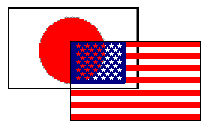
The Crusader may have been an attempt to undercut the market for the Fuji/Rockwell venture, to prevent the Japanese manufacturer from getting a foothold in the American lightplane market. By producing a comparable aircraft, quickly, at a lower price, it may have been possible for Cessna to discourage Japanese competitors from attempting an invasion of the American general-aviation market.
If that was the case, it seems to have worked. A year after Cessna flew their T303 Crusader prototype, Rockwell announced it was cancelling its deal with Fuji, after selling only about two-dozen 700's, and the Japanese company never gained a foothold in the American aviation market. Indeed, no Japanese company has done so since. (Mitsubishi, maker of the speedy "MU-2" turboprop twins, had established itself in America a decade earlier, but in with limited effect. In the 1980's, Mitsubishi sold its Diamond bizjet -- factory and all -- to Wichita's Raytheon Aircraft.).

In any event, regardless of whatever actually happens to create the T303, its influence doesn't last long. No strong demand materializes for the T303. It would have been inefficient for Cessna to cast aside an assembly line after having invested hundreds of thousands (probably millions) of dollars to tool up for it. So over next few years, somehow, Cessna manages to sell 297 Crusaders. But they are never anywhere nearly as popular as Cessna's true cabin-class planes -- the 400 series -- let alone Cessna's other "cheap" twins -- the 310 and the 337 SuperSkymaster. After just a few years, as the lingering Great Recession and growing litigation take their toll, Cessna drops all of its propellor-driven aircraft from production, pulling the Crusader from the Cessna line in 1986, along with most of the rest of its propellor fleet.
 Today, the various Cessna twin-prop aircraft have all been discontinued. During the Great Recession of 1981-1992, Cessna ended its entire production of propellor-driven aircraft -- most in 1986. Cessna blamed the economy, but made muffled references to the mounting cost of lawsuits from crashes of its propellor planes -- commonly flown by less-than-expert pilots (particularly private pilots and novice commercial pilots).
Today, the various Cessna twin-prop aircraft have all been discontinued. During the Great Recession of 1981-1992, Cessna ended its entire production of propellor-driven aircraft -- most in 1986. Cessna blamed the economy, but made muffled references to the mounting cost of lawsuits from crashes of its propellor planes -- commonly flown by less-than-expert pilots (particularly private pilots and novice commercial pilots).
Following Congressional passage of the GARA (General Aviation Revitalization Act), which gave the light-plane manufacturers some immunity from liabliity in U.S. crash lawsuits, Cessna returned to building some of its previous single-engine lineup -- as well as a new single-engine plane which Cessna developed for commercial operators only (the Caravan). However, this dominator of the light plane industry has not returned to the manufacture of any of its prop twins, and shows no signs of doing so anytime soon.
This may be attributable to the fact that he crash record for twin engine light aircraft is worse than for singles, and that twins can involve much higher crash liability -- because of their value, the number of people they can hold, the amount of damage they can do to others in an impact, and the greater likelihood that a wealthy person or executive will be killed in twin crashes. (Juries commonly believe in awarding more money to the survivors of a person whose salary history reflects great income).
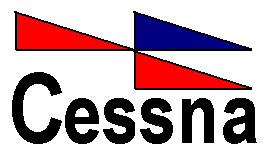 Nevertheless, most of Cessna's popular twins still remain widely available on the used market, and some are still in demand, and still command a good price. Indeed, some -- like the turboprop Model 441 -- have actually become more in demand after their passing, than while they were being manufactured.
Nevertheless, most of Cessna's popular twins still remain widely available on the used market, and some are still in demand, and still command a good price. Indeed, some -- like the turboprop Model 441 -- have actually become more in demand after their passing, than while they were being manufactured.
 Return to Cessna History Timeline
Return to Cessna History Timeline
